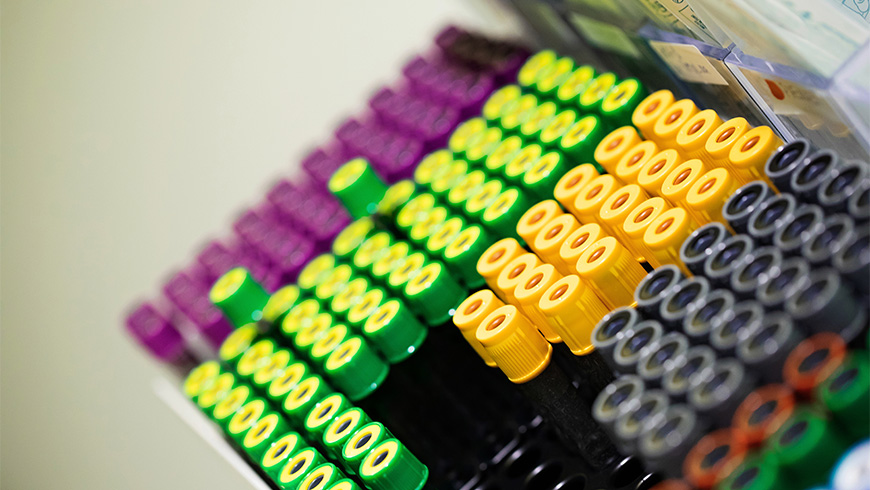
The basic blood count (B-PVKT) is an important basic laboratory test that provides a variety of ways to analyse the condition of the body. Basic blood count can be used to detect various disorders of the body, such as haemorrhages, inflammations, haematopoietic disorders in the bone marrow and a range of issues with nutrition or absorption. The basic blood count also includes the measurement of the blood platelet count, also known as thrombocytes (B-Trom), which are required in stopping a bleed (haemostasis).
Tests included in the basic blood count and their reference values
The basic blood count includes the following laboratory tests. The reference values for different age groups and genders are also included in the list. The prefix “B” means that the sample analysed is whole blood, of which the cells to be analysed are extracted. The prefix “E” refers to red blood cells or erythrocytes. The prefix “L” is used to indicate the analysis of white blood cells or leukocytes. Only a single needle puncture is required to analyse all these parts.
- B-Leuk (total white blood cell count): 3.4–8.2 109/l
- B-Hb (haemoglobin): women 117–155 g/l, men 134–167 g/l
- B-Hkr (haematocrit, volume percentage of red blood cells in blood): women 35–46 %, men 39–50 %
- B-Eryt (erythrocyte or red blood cell count): women 3.90–5.20 x 1012/l, men 4.25–5.70 x 1012/l
- E-MCV (mean corpuscular volume of red cells): 82–98 fl
- E-RDW (red blood cell distribution width): women below 15 %, men below 14 %.
- E-MCH (mean red blood cell haemoglobin mass): 27–33 pg/cell
- E-MCHC (mean corpuscular haemoglobin concentration in red blood cells): 320–355 g/l
- B-Trom (thrombocyte or blood cell platelet count): 150–360 x 109/l
To whom is the basic blood count recommended?
The basic blood count test should be performed if your haemoglobin count is usually low, you are vegetarian, you experience the symptoms of anaemia, for example, or if there are any additional reasons to suspect the presence of an anomaly. Anaemia refers to a low haemoglobin (B-Hb) count. The causes of a possible anaemia must always be examined before a treatment can be initiated, and the effects of treatment should be monitored.
Increased white blood cell count (B-Leuk) may be due to various circumstances that do not involve an illness. For example, pregnancy, physical or mental stress, eating, smoking or a cortisone medication can increase the white blood cell count. Inflammations caused by viral and bacterial infections, in particular, are known to increase the white blood cell count temporarily. Malignant blood disorders, such as leukaemia, can make the white blood cell count very high. If the white blood cell count is very low, however, the risk of infections increases significantly. If there are any inexplicable anomalies detected in the B-Leuk test, a differential white blood cell count can be performed with a complete blood count test (TVK).
The basic blood count also includes the measurement of the blood platelet count, also known as thrombocytes (B-Trom), which are required in stopping a bleed (haemostasis). Inflammations caused by viral and bacterial infections, medications and excessive alcohol consumption that disrupts the functionality of bone marrow can have a temporary effect on the blood platelet count. If the blood platelet count is considerably low (thrombocytopaenia), a risk of haemorrhaging may be present. Minor decrease in the blood platelet count cannot cause any haemorrhaging, however, as there are other factors in the blood that have a coagulative effect.
How to request these tests?
The basic blood count test can be performed in the laboratories of Mehiläinen without a referral. The test does not require any particular preparations, such as fasting or taking the sample at a certain time of the day.
The price of the basic blood count test is available in Mehiläinen’s laboratory test price list.
How can I view the results?
The results of laboratory tests are stored in the OmaMehiläinen service, where you can browse them whenever you like. You can access the OmaMehiläinen service on your phone by downloading the OmaMehiläinen mobile application from the App Store or Google Play. A browser version of the OmaMehiläinen service is also available.
Download the OmaMehiläinen mobile application for iPhone
Download the OmaMehiläinen mobile application for Android devices
Expert consulted for the article: Kristina Hotakainen, Director, Laboratory Services.